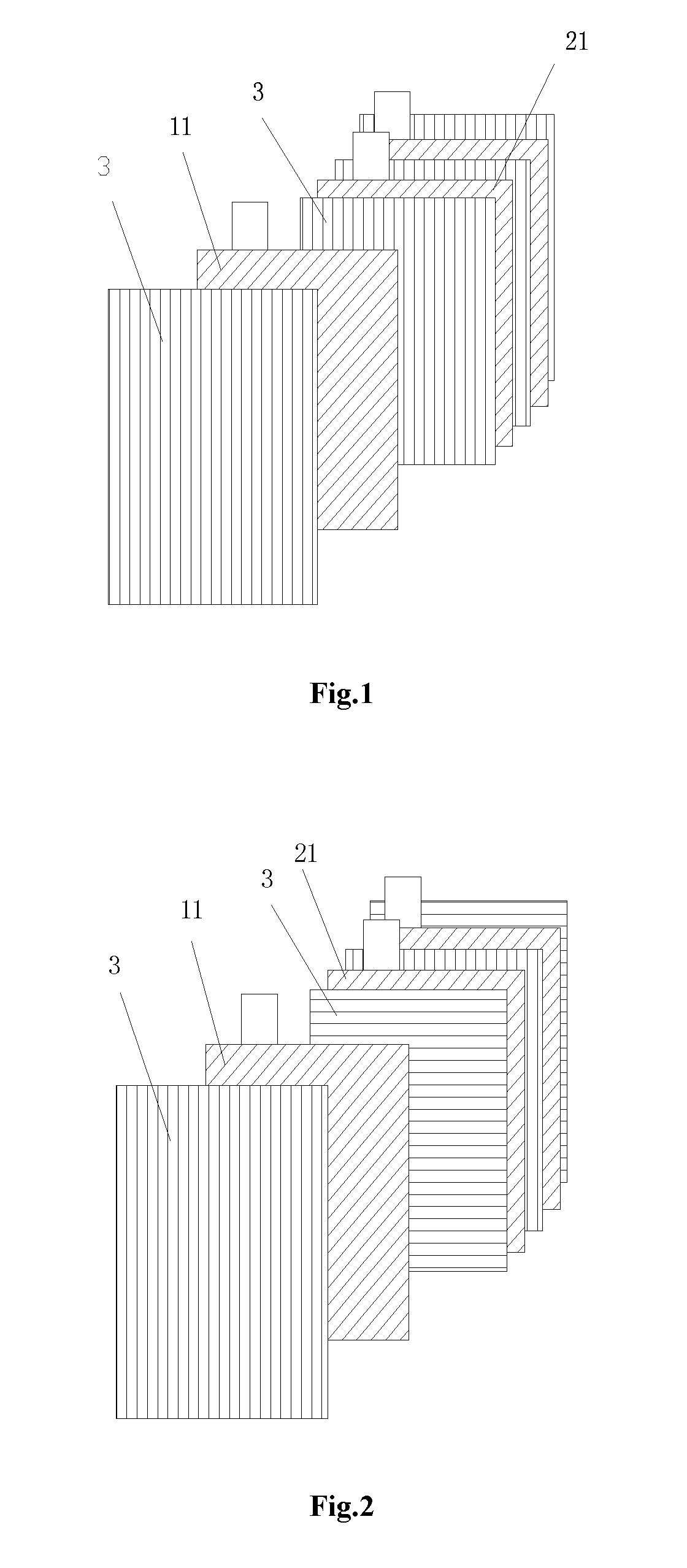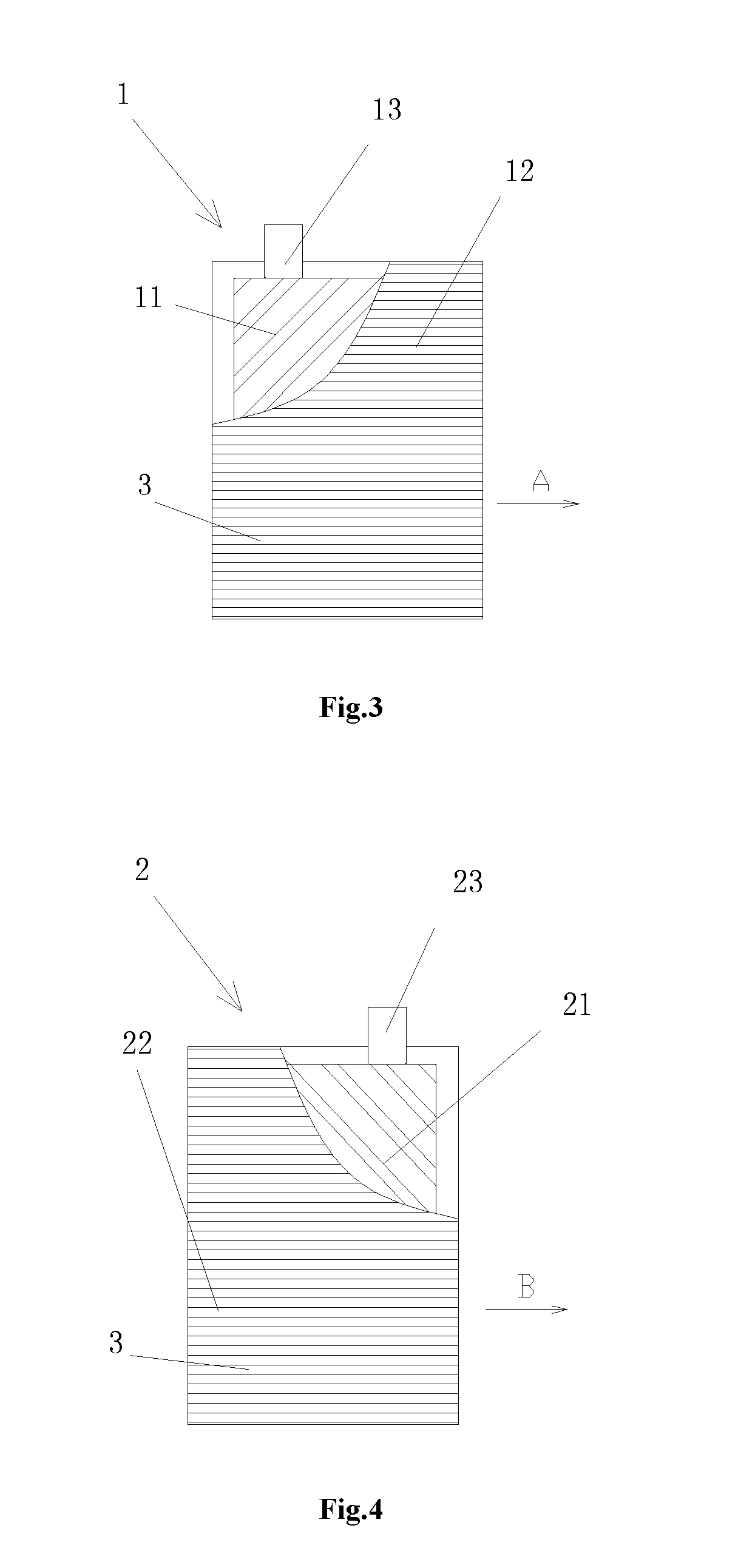Stacked-Type Lithium Ion Battery
a lithium ion battery and stacked technology, applied in the manufacture of final products, cell components, cell component details, etc., can solve the problems of high internal and external pressure on each side of the core, high tensile force in all directions, short circuit in the battery, etc., and achieves the effect of enhancing battery safety performance and low tensile strength directions
- Summary
- Abstract
- Description
- Claims
- Application Information
AI Technical Summary
Benefits of technology
Problems solved by technology
Method used
Image
Examples
embodiment 1
[0043]Here, we take the horizontal direction as X-direction and the direction perpendicular to horizontal direction as Y-direction.
[0044]The positive plate 11 and negative plate 21 are obtained by cutting; the positive plate 11 and the negative plate 21 have an uncoated positive electrode tab and negative electrode tab respectively. Then, the membranes prepared through a uniaxial tension process are cut into membranes 3 that are slightly larger than the positive and negative plates, with tensile directions in horizontal direction (X-direction) and vertical direction (Y-direction). As shown in FIG. 2, the membranes 3 with tensile directions perpendicular to each other are stacked with the positive and negative plates in sequence to form the battery core, in particularly as follows: membrane 3 with tensile direction in X-direction / positive plate 11 / membrane 3 with tensile direction in Y-direction / negative plate 21 / membrane 3 with tensile direction in X-direction / positive plate 11 / . ....
embodiment 2
[0045]The preparation procedures are similar to those for the embodiment 1, with the difference as: there are two membranes 3 between positive plate and negative plate, and the two membranes 3 have different tensile directions; preferably, the two membranes 3 have 90° included angle between their tensile directions.
embodiment 3
[0046]The membranes 3 are obtained by cutting in X-direction; said membranes 3 are 1-3 mm larger than the positive plates 11 in length and width. Then, two membranes 3 of the same size are stacked together, welded on one longer edge and one shorter edge to form a positive membrane bag 12; the positive plate 11 obtained by cutting is placed into the positive membrane bag 12; then, the positive membrane bag 12 is welded on the other longer edge and the other shorter edge, to form the positive plate assembly 1. The negative plate assembly can be prepared through similar procedures as the positive plate assembly, with the only difference that the membranes for fabricating the negative membrane bag 22 are cut in Y-direction.
[0047]The positive plate assembly 1 and the negative plate assembly 2 are shown in FIG. 5-FIG. 8; wherein, the positive plate assembly shown in FIG. 5 has tensile direction (direction A) in horizontal direction (X-direction), while the negative plate assembly shown in...
PUM
| Property | Measurement | Unit |
|---|---|---|
| relative angle | aaaaa | aaaaa |
| relative angle | aaaaa | aaaaa |
| relative angle | aaaaa | aaaaa |
Abstract
Description
Claims
Application Information
 Login to View More
Login to View More - R&D
- Intellectual Property
- Life Sciences
- Materials
- Tech Scout
- Unparalleled Data Quality
- Higher Quality Content
- 60% Fewer Hallucinations
Browse by: Latest US Patents, China's latest patents, Technical Efficacy Thesaurus, Application Domain, Technology Topic, Popular Technical Reports.
© 2025 PatSnap. All rights reserved.Legal|Privacy policy|Modern Slavery Act Transparency Statement|Sitemap|About US| Contact US: help@patsnap.com



